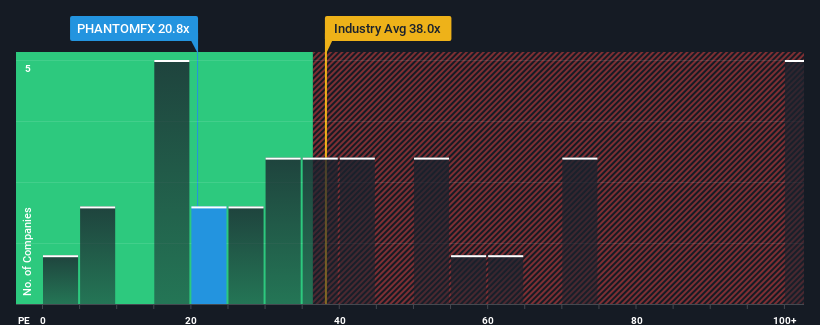- India
- /
- Entertainment
- /
- NSEI:PHANTOMFX
Slammed 28% Phantom Digital Effects Limited (NSE:PHANTOMFX) Screens Well Here But There Might Be A Catch
The Phantom Digital Effects Limited (NSE:PHANTOMFX) share price has fared very poorly over the last month, falling by a substantial 28%. Longer-term shareholders would now have taken a real hit with the stock declining 6.9% in the last year.
Although its price has dipped substantially, given about half the companies in India have price-to-earnings ratios (or "P/E's") above 31x, you may still consider Phantom Digital Effects as an attractive investment with its 20.8x P/E ratio. Nonetheless, we'd need to dig a little deeper to determine if there is a rational basis for the reduced P/E.
The earnings growth achieved at Phantom Digital Effects over the last year would be more than acceptable for most companies. One possibility is that the P/E is low because investors think this respectable earnings growth might actually underperform the broader market in the near future. If you like the company, you'd be hoping this isn't the case so that you could potentially pick up some stock while it's out of favour.
Check out our latest analysis for Phantom Digital Effects

Does Growth Match The Low P/E?
The only time you'd be truly comfortable seeing a P/E as low as Phantom Digital Effects' is when the company's growth is on track to lag the market.
Taking a look back first, we see that the company grew earnings per share by an impressive 23% last year. The strong recent performance means it was also able to grow EPS by 19,639% in total over the last three years. Therefore, it's fair to say the earnings growth recently has been superb for the company.
This is in contrast to the rest of the market, which is expected to grow by 25% over the next year, materially lower than the company's recent medium-term annualised growth rates.
In light of this, it's peculiar that Phantom Digital Effects' P/E sits below the majority of other companies. It looks like most investors are not convinced the company can maintain its recent growth rates.
The Final Word
Phantom Digital Effects' recently weak share price has pulled its P/E below most other companies. Typically, we'd caution against reading too much into price-to-earnings ratios when settling on investment decisions, though it can reveal plenty about what other market participants think about the company.
We've established that Phantom Digital Effects currently trades on a much lower than expected P/E since its recent three-year growth is higher than the wider market forecast. When we see strong earnings with faster-than-market growth, we assume potential risks are what might be placing significant pressure on the P/E ratio. At least price risks look to be very low if recent medium-term earnings trends continue, but investors seem to think future earnings could see a lot of volatility.
You always need to take note of risks, for example - Phantom Digital Effects has 3 warning signs we think you should be aware of.
Of course, you might also be able to find a better stock than Phantom Digital Effects. So you may wish to see this free collection of other companies that have reasonable P/E ratios and have grown earnings strongly.
New: Manage All Your Stock Portfolios in One Place
We've created the ultimate portfolio companion for stock investors, and it's free.
• Connect an unlimited number of Portfolios and see your total in one currency
• Be alerted to new Warning Signs or Risks via email or mobile
• Track the Fair Value of your stocks
Have feedback on this article? Concerned about the content? Get in touch with us directly. Alternatively, email editorial-team (at) simplywallst.com.
This article by Simply Wall St is general in nature. We provide commentary based on historical data and analyst forecasts only using an unbiased methodology and our articles are not intended to be financial advice. It does not constitute a recommendation to buy or sell any stock, and does not take account of your objectives, or your financial situation. We aim to bring you long-term focused analysis driven by fundamental data. Note that our analysis may not factor in the latest price-sensitive company announcements or qualitative material. Simply Wall St has no position in any stocks mentioned.
About NSEI:PHANTOMFX
Phantom Digital Effects
Operates as a visual effects (VFX) studio company in India, Canada, the United States, the United Kingdom, and Dubai.
Excellent balance sheet with proven track record.
Similar Companies
Market Insights
Community Narratives


Recently Updated Narratives

Constellation Energy Dividends and Growth

CoreWeave's Revenue Expected to Rocket 77.88% in 5-Year Forecast

Bisalloy Steel Group will shine with a projected profit margin increase of 12.8%
Popular Narratives


MicroVision will explode future revenue by 380.37% with a vision towards success


NVDA: Expanding AI Demand Will Drive Major Data Center Investments Through 2026



